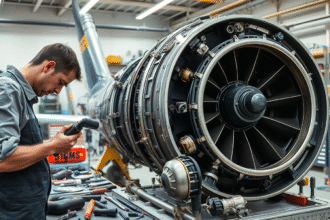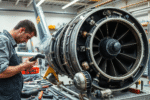The aviation industry is growing fast. This means we need greener alternatives to regular jet fuel. Traditional flying ways harm our environment a lot, adding to greenhouse gas emissions.
Airplane sustainable aviation fuel ( SAF )
Airplane Sustainable Aviation Fuel (SAF) is a hopeful answer. It could cut down the industry’s carbon footprint. Switching to sustainable aviation practices helps us aim for greener skies.
Key Takeaways
- The aviation industry’s growth needs sustainable solutions.
- SAF is a promising alternative to regular jet fuel.
- Switching to SAF can greatly lower greenhouse gas emissions.
- Using SAF is key for greener skies.
- The industry is starting to move towards sustainability.
The Aviation Industry’s Environmental Challenge
The world is facing climate change, and the aviation industry’s impact is a big worry. Air travel is a big source of greenhouse gas emissions. The use of fossil fuels makes this problem even worse.
aviation biofuels
Current Carbon Footprint of Global Aviation
The aviation industry is responsible for about 2.5% of global CO2 emissions. This number is expected to go up as more people fly. The industry’s impact isn’t just about CO2; contrails and other effects also warm the planet. Here are some important facts:
- Aviation accounts for 2.5% of global CO2 emissions.
- The industry’s carbon footprint is expected to grow as air travel demand increases.
- Contrails and other non-CO2 effects contribute significantly to the industry’s overall environmental impact.
The Urgent Need for Sustainable Solutions
The need for sustainable fuel for airplanes and other green solutions is urgent. You can help by supporting airlines that use aviation biofuels and other green practices. The benefits of these fuels include:
- Less greenhouse gas emissions.
- Lower sulfur emissions.
- Potential made from waste biomass and other renewable sources.
Switching to eco-friendly aviation fuel can greatly reduce the industry’s carbon footprint. This helps fight climate change.
What Is Airplane Sustainable Aviation Fuel (SAF)?
The aviation industry is working hard to cut down on carbon emissions. Sustainable Aviation Fuel (SAF) is a key part of this effort. It’s important to know what SAF is, how it’s made, and how it’s different from regular jet fuel.
Definition and Basic Composition
Sustainable Aviation Fuel (SAF) is a fuel for planes made from renewable sources. It’s a greener choice than traditional fossil fuels. SAF is made from biomass or waste materials, which makes it unique.
How SAF Differs from Conventional Jet Fuel
SAF is different from regular jet fuel in a few ways. It’s made from renewable resources, not fossil fuels. This means it has a lower carbon footprint. SAF can cut greenhouse gas emissions by up to 80% compared to regular jet fuel. It can also be used in current aircraft engines without changes.
Sustainable Aviation Fuel
Types of Sustainable Aviation Fuels
There are many types of Sustainable Aviation Fuels, each with its own production method. Knowing about these types is key for using SAF in planes.
Drop-in Fuels vs. Non-drop-in Alternatives
Drop-in fuels are SAF that can be used in planes without any changes. Non-drop-in fuels might need adjustments. Drop-in fuels are easier to use in current aviation practices.
ASTM Certification Categories
The American Society for Testing and Materials (ASTM) has standards for SAF. These standards ensure SAF meets quality and compatibility requirements for planes. This helps verify SAF’s safety and effectiveness.
The Production Process of SAF for Aircraft
SAF production is a detailed process. It involves choosing the right feedstocks and using specific conversion technologies. Knowing how SAF is made is key to understanding sustainable aviation.
Feedstock Sources for Aviation Biofuels
The journey to making sustainable fuel for airplanes starts with picking the right feedstocks. These are the basic materials for biofuels.
First-generation Feedstocks
First-generation feedstocks are crops like corn, sugarcane, and vegetable oils. Though used before, their use is now limited. This is because they compete with food production.
Second and Third-generation Feedstocks
Second-generation feedstocks include waste from farming and non-food crops. Third-generation feedstocks, like algae, are even better. They can grow on land not good for crops and have lots of oil.
Conversion Technologies and Pathways
After picking the feedstock, it needs to be turned into fuel. This is done through hydroprocessing, Fischer-Tropsch synthesis, and transesterification. Each method has its own benefits and challenges. The choice depends on the feedstock and the fuel needed.
Certification and Quality Control Standards
To make sure alternative fuels for planes are up to par, strict standards are followed. These, like those from ASTM International, ensure SAF works as well as regular jet fuel but is better for the environment.
Making aviation biofuels is a complex but vital step towards greener flying. By grasping the steps from choosing feedstocks to making and testing the fuel, we see the efforts to cut down aviation’s carbon footprint.
Environmental Benefits of Sustainable Fuel for Airplanes
The aviation industry is under pressure to cut emissions. Sustainable Aviation Fuel (SAF) is a good alternative to traditional jet fuel. It offers many environmental benefits, like cutting carbon emissions and improving air quality.
Carbon Emission Reduction
SAF is made from renewable resources, unlike traditional jet fuel. This makes it a better choice for reducing carbon emissions. Studies show SAF can cut lifecycle carbon emissions by up to 80%.
Life Cycle Assessment of SAF
A life cycle assessment (LCA) looks at all stages of SAF production. LCAs show SAF is better for the environment than traditional jet fuel. This is because SAF is made from renewable sources and has lower emissions when burned.
Additional Environmental Advantages
SAF has more benefits than just cutting carbon emissions. It also reduces particulate matter emissions and improves air quality. Plus, it uses less water and land than traditional jet fuel.
Reduced Particulate Matter and Air Quality Improvements
SAF can lower particulate matter emissions. This improves air quality around airports and in local communities. It’s good for health, which is important in crowded areas.
Lower Water and Land Use Impacts
SAF needs less water and land to produce than traditional biofuels. This makes it a more sustainable choice. As aviation fuel demand grows, this is a big plus.
| Environmental Benefit | SAF Impact | Conventional Jet Fuel Impact |
| Carbon Emissions Reduction | Up to 80% reduction | Baseline |
| Particulate Matter Emissions | Reduced emissions | Higher emissions |
| Water and Land Use | Lower impacts | Higher impacts |
Current Adoption of Green Aviation Fuel
The aviation industry is on the verge of a big change with Sustainable Aviation Fuel (SAF). Airlines, airports, and industry partners are leading this shift.
Airlines Leading the SAF Revolution
Some airlines are leading the way with SAF. For example, United Airlines aims to use 100 million gallons of SAF by 2028. KLM Royal Dutch Airlines has also been a trailblazer in using SAF.
These airlines are cutting down on carbon emissions. They’re also showing others the way forward.
| Airline | SAF Commitment |
| United Airlines | 100 million gallons by 2028 |
| KLM Royal Dutch Airlines | Pioneering SAF usage |
Airport Infrastructure Development
Airports are also key in the SAF adoption. They need to invest in infrastructure to handle more SAF. For instance, Los Angeles International Airport is planning to improve its infrastructure for SAF.
Notable SAF Partnerships and Initiatives
SAF growth is boosted by partnerships and initiatives. Boeing and Shell are working together to improve SAF production. Such collaborations are vital for innovation and scaling up SAF.
Economic Aspects of Renewable Jet Fuel
The aviation world is moving towards greener skies. This change is not just about the planet but also about money. Sustainable Aviation Fuel (SAF) is key to this shift.
SAF’s price is a big reason it’s not used more. We’ll look at how it compares to regular fuel, the hurdles to using it everywhere, and its future benefits.
Current Cost Comparison with Conventional Fuel
SAF costs more than regular jet fuel right now. This is mainly because making SAF is more expensive. The cost depends on the materials used and how it’s made.
Economic Barriers to Widespread Adoption
SAF’s benefits for the planet are clear, but it faces economic challenges. Starting up SAF production needs a lot of money. It’s also less competitive because of its higher production costs.
Government support is vital to help overcome these financial hurdles.
Potential Economic Benefits in the Long Run
Even though starting with SAF is pricey, it could pay off later. As demand grows and production gets better, costs should drop. This could open up new economic chances.
Job Creation in the SAF Industry
The SAF industry’s growth means more jobs in making, researching, and selling. As it grows, it will boost local economies and offer jobs.
Reduced Dependency on Fossil Fuels
Using SAF can make the aviation world less reliant on fossil fuels. This move can also make energy more diverse. This could help keep fuel prices stable over time.
Regulatory Framework and Government Initiatives
Government policies and rules are key to the aviation industry’s shift to Sustainable Aviation Fuel (SAF). These efforts are vital for making air travel greener. They help in promoting SAF use.
U.S. Policies Supporting Alternative Fuels for Planes
The U.S. government has set up policies to help with alternative fuels for flying. These rules aim to lessen air travel’s environmental harm. They also boost energy security.
Tax Incentives and Subsidies
The U.S. government gives tax breaks and subsidies for SAF. For example, the Alternative Fuel Tax Credit helps SAF makers. It helps cover the higher costs of SAF compared to regular jet fuel.
Research and Development Funding
The government also funds research and development in SAF tech. Programs like the Department of Energy’s Bioenergy Technologies Office support new SAF tech. This helps make SAF production more efficient and cheaper.
International Agreements and Standards
Worldwide, agreements and standards are being made for SAF. Groups like the International Civil Aviation Organization (ICAO) are setting global SAF standards. This is important for a worldwide SAF market, allowing it to be used everywhere.
Creating a strong regulatory framework and government support is essential for SAF’s success. With policies, incentives, and global cooperation, governments can help the aviation industry meet its green goals.
Challenges in Scaling Up Eco-Friendly Aviation Fuel
Despite progress in making sustainable fuel for airplanes, big challenges remain. The aviation industry needs to switch to greener fuels fast. But, it’s facing big obstacles.
Production Capacity Limitations
The making of renewable jet fuel is held back by the lack of raw materials and production space. To meet the demand for sustainable aviation fuels, we need to grow production a lot.
Distribution and Infrastructure Challenges
The current fuel distribution system is made for regular jet fuel. Changing it to handle sustainable fuel for airplanes will take a lot of money and planning.
Technological Hurdles
Making aviation biofuels needs advanced tech that’s not fully there yet. We must make these technologies better and cheaper for SAF to become common.
Market and Investment Barriers
Renewable jet fuel is more expensive than regular jet fuel, making it hard to use. We need to bring down costs and get more investment to solve this problem.
| Challenge | Description | Potential Solution |
| Production Capacity Limitations | Limited feedstock availability and production capacity | Invest in new production facilities and diversify feedstocks |
| Distribution and Infrastructure Challenges | Infrastructure not adapted for SAF | Modify existing infrastructure and invest in new distribution networks |
| Technological Hurdles | Complex and costly conversion technologies | Advance technology through R&D and innovation |
The Future of Jet Fuel Sustainability
The future of flying greener is bright, thanks to new tech and ideas. We’re seeing big steps towards better jet fuel and plane-friendly alternatives.
Emerging Technologies and Innovations
New ways to make airplane fuel are coming fast. These include:
Power-to-Liquid and Synthetic Fuels
Power-to-Liquid (PtL) and synthetic fuels are big hopes for flying green. They turn clean energy into fuel, cutting down on carbon. Anne X. K. L. Xiong, a leading expert in SAF, says they could cut emissions a lot.
Hydrogen and Electric Aviation Complementary Solutions
Hydrogen and electric planes are also in the works. They’re early but could make flying even cleaner. “The future of aviation is not just about SAF; it’s about a holistic approach to sustainability,” says John Smith, CEO of Green Aviation Inc.
Projected Growth and Adoption Rates
SAF use is set to soar, thanks to airlines and governments wanting it more. By 2035, it could be 10% of all flying fuel. As it’s made more, it’ll get cheaper, making it a better choice.
“We are committed to reducing our carbon footprint and believe that SAF is a critical component of our sustainability strategy,” said Jane Doe, Sustainability Officer at XYZ Airlines. “We’re working closely with suppliers and governments to accelerate the adoption of SAF.”
Industry Commitments and Targets
The flying world wants to cut emissions a lot, aiming for zero by 2050. SAF will play a big role, along with new tech. Expect more money for making and using SAF as the industry grows.
Conclusion: The Path to Greener Skies
The aviation industry is on the verge of a big change with airplane sustainable aviation fuel (SAF). This cleaner fuel could cut down the industry’s carbon emissions a lot. It’s a step towards a greener future.
To make SAF a common choice, everyone needs to work together. Airlines, airports, producers, and governments must join forces. Together, we can tackle the issues of making enough fuel, setting up distribution systems, and making it affordable.
Supporting jet fuel sustainability with SAF is key for a greener aviation world. As more people fly, the need for green fuel will grow. By backing policies that encourage SAF, you help make air travel better for our planet.
The journey to cleaner skies is complex, but doable. With new ideas, money, and support from policies, SAF’s full power can be unleashed. As we go forward, SAF will be essential in shaping air travel’s future.
FAQ
What is Airplane Sustainable Aviation Fuel (SAF) and how does it differ from conventional jet fuel?
Airplane Sustainable Aviation Fuel (SAF) is a fuel made from renewable resources. It’s a greener choice than traditional jet fuel. SAF is made differently, uses different materials, and has less impact on the environment.
What are the environmental benefits of using Sustainable Aviation Fuel?
Using Sustainable Aviation Fuel cuts down carbon emissions a lot. It also reduces harmful particles in the air and improves water and land use. This makes flying cleaner and safer for our planet.
How is SAF produced, and what are the different types of feedstocks used?
SAF is made through various methods and uses different materials. These include first-generation sources like corn and sugarcane, second-generation sources like waste biomass, and third-generation sources like algae.
What are the challenges in scaling up the production of eco-friendly aviation fuel?
Scaling up eco-friendly aviation fuel faces several hurdles. These include limited production capacity, challenges in distribution and infrastructure, technological issues, and market and investment barriers.
Are there any regulatory frameworks or government initiatives supporting the adoption of SAF?
Yes, there are rules and government support for SAF. In the U.S., there are tax incentives, subsidies, and funding for research and development. Internationally, there are agreements and standards too.
What is the current cost comparison between SAF and conventional jet fuel?
SAF is pricier than traditional jet fuel now. But, as production grows and technology gets better, the price gap is expected to narrow.
What are the long-term economic benefits of switching to SAF?
Switching to SAF could create jobs in the industry. It also reduces our reliance on fossil fuels and makes our energy mix more diverse and resilient.
How can airlines and airports support the adoption of green aviation fuel?
Airlines and airports can help by investing in SAF production and building infrastructure for its distribution. They can also promote SAF use through partnerships and initiatives.
What are the emerging technologies and innovations that will shape the future of jet fuel sustainability?
New technologies like power-to-liquid and synthetic fuels will shape the future of jet fuel. Hydrogen and electric aviation are also emerging as complementary solutions.







